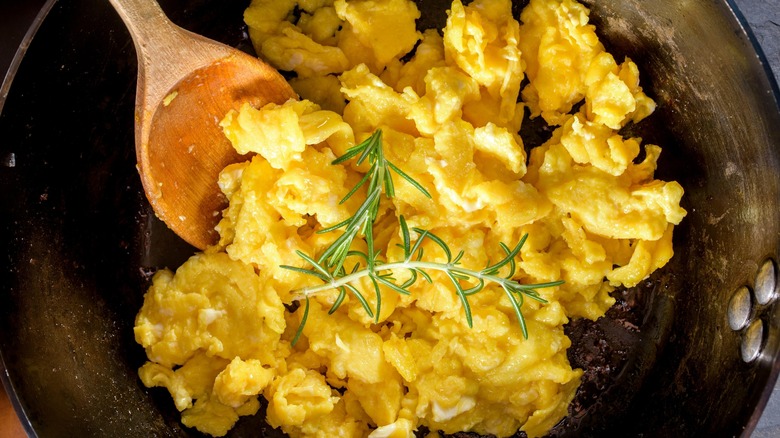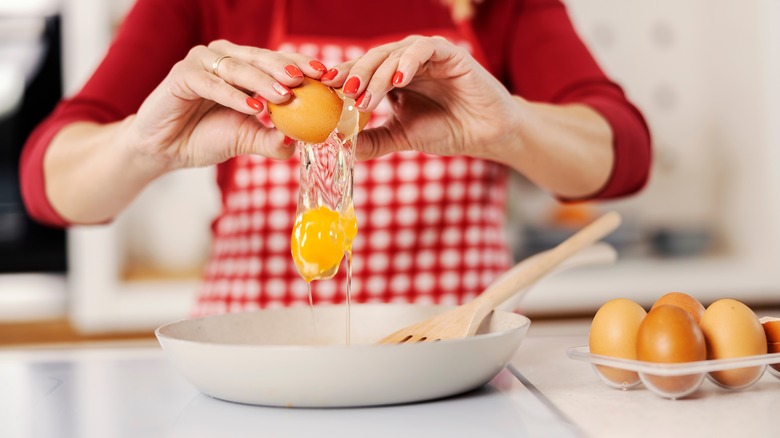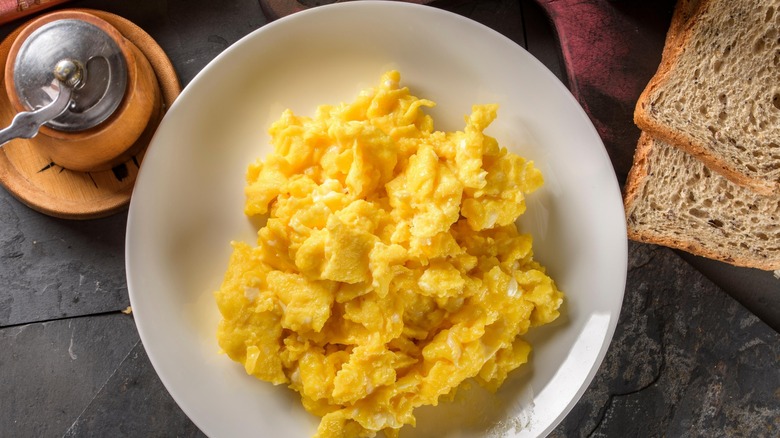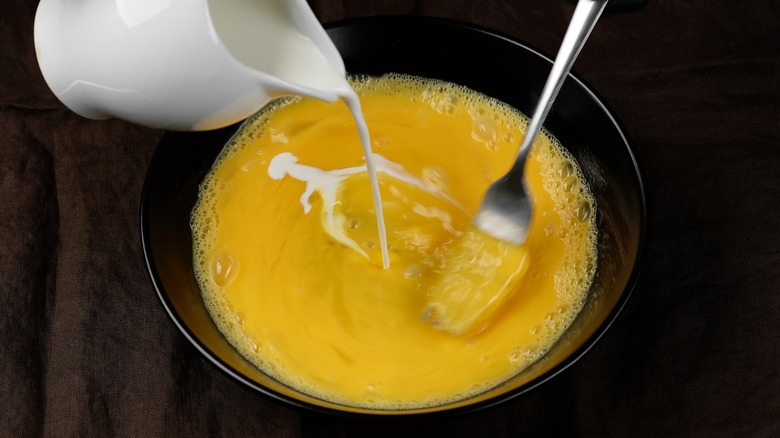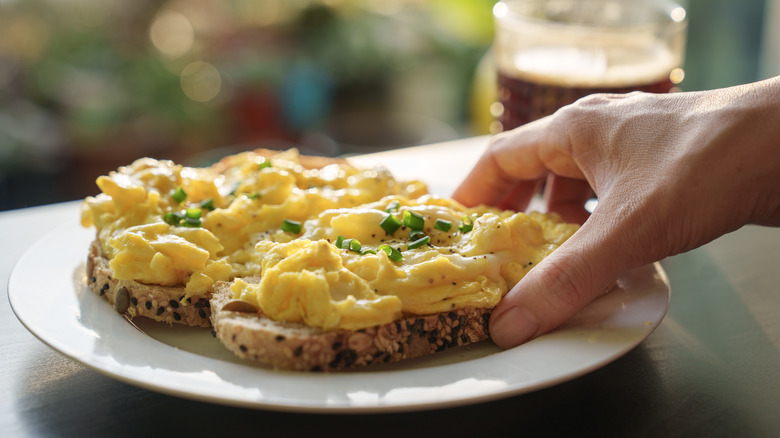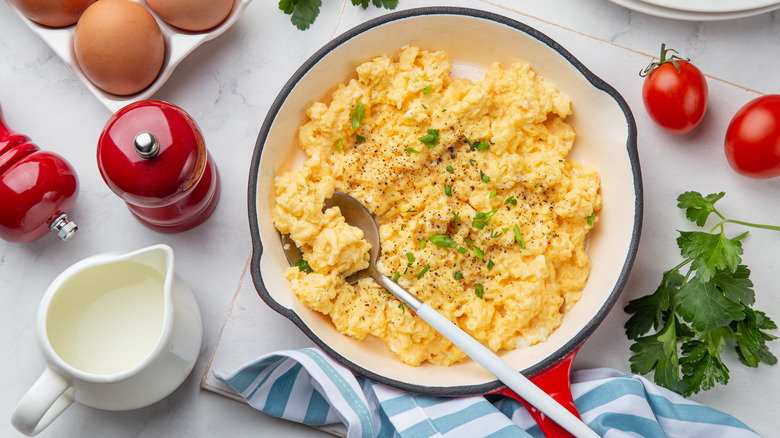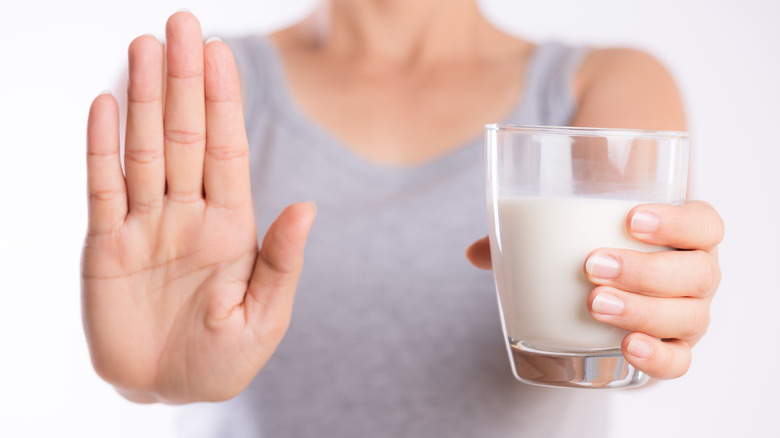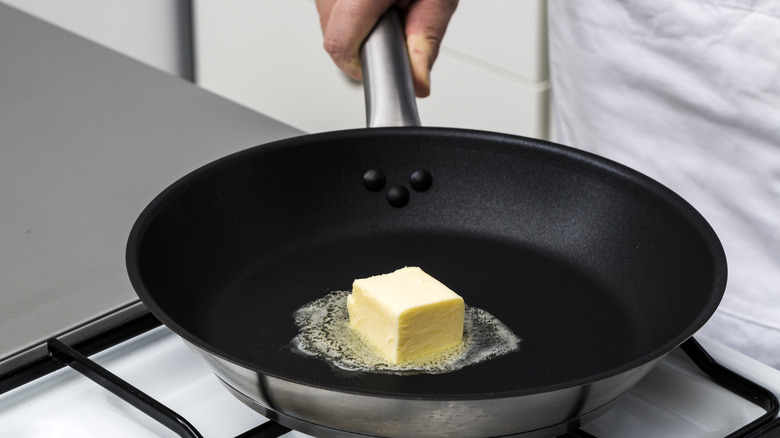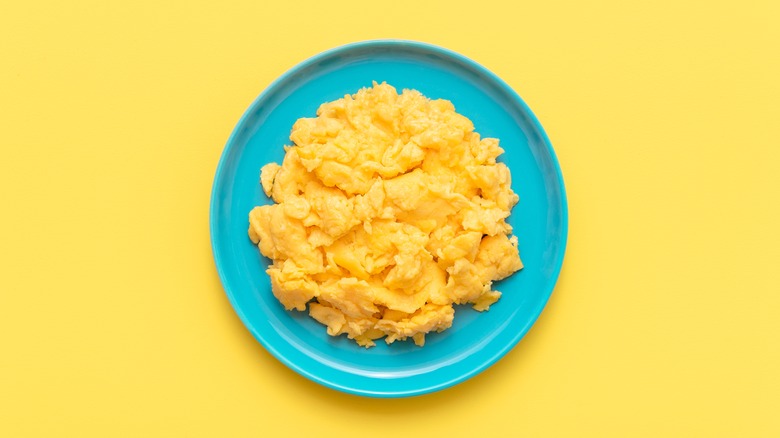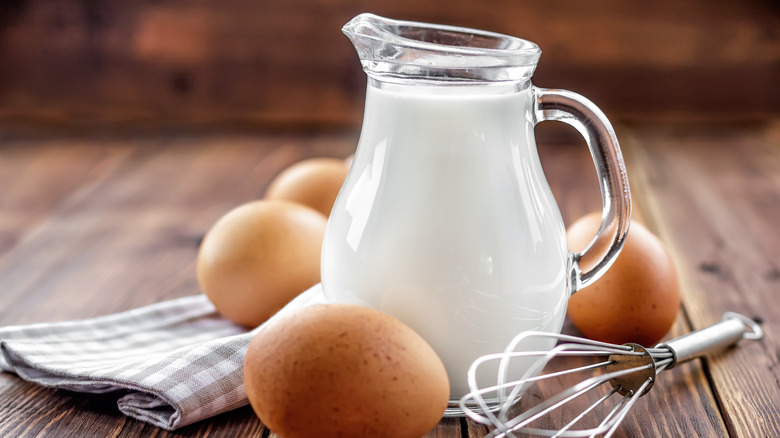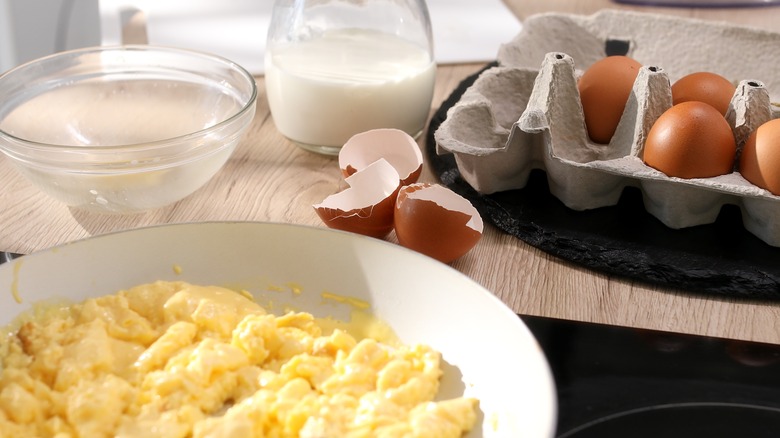Water Vs Milk: Here's What You Need To Know When Making Fluffy Scrambled Eggs
If you're looking to level up your scrambled egg game, knowing which liquids make the best eggs is a fantastic place to start. There are many liquids that turn scrambled eggs into a masterpiece, but water and milk are the most common. So, how does each affect the final outcome? Does one lead to fluffier scrambled eggs than the other? While both water and milk have their benefits and lead to tastier, moister results than when made dry, the liquid you use undoubtedly alters the texture. It also changes the taste, color, and nutritional value overall (even if it's just by a small amount). As a result, it's not uncommon to wonder whether water or milk makes the fluffiest scrambled eggs, regardless of your skill level in the kitchen.
To determine if milk or water makes the fluffiest scrambled eggs, I considered my personal experience preparing them at home. I also researched Reddit forums for popular opinions and celebrity chef recommendations. After all, if they don't know, who does? I'll explain my methodology in more detail at the end, but for now, keep reading to find out what I discovered. That way, the next time you whip up some delicious scrambled eggs you'll know exactly what to expect when you add water or milk — or, uh, maybe even just butter.
Making scrambled eggs requires extra liquid
Scrambled eggs are a seemingly simple dish to make. However, if you want the tastiest, fluffiest scrambled eggs, it all comes down to the minute details. For example, if you cook them without any seasoning, they'll likely be relatively bland compared to adding a pinch of salt (at the very least). Or, if you cook them without any liquid, they'll almost certainly be dry and unimpressive. Don't worry though. There's a surefire way to improve scrambled eggs and all it takes is a dash of liquid and a bit of salt and pepper.
In general, about 1 tablespoon of liquid per egg is needed to make scrambled eggs, and both water and milk work wonders. Some chefs prefer to use only butter, but when melted, it adds lots of decadent moisture to scrambled eggs as well. Really, any liquid will do, but milk and water are typically what cooks whisk into their scrambled eggs. Of course, Gordon Ramsay never whisks his scrambled eggs, but don't get hung up on this detail. For now, suffice it to say that a bit of liquid, whether it's milk, butter, water, or something else transforms bland, boring scrambled eggs into something a chef would be proud to serve.
Scrambled eggs with water are fluffier
In a head-to-head competition for the fluffiest scrambled eggs, water beats milk every time. Not only have I witnessed this first hand, but the general consensus is that if you want super fluffy eggs, you add water. Making scrambled eggs with milk has its benefits, but it weighs them down. Water, on the other hand, fluffs them up nicely. As the water evaporates during the cooking process, it "lifts" the eggs and makes them noticeably fluffier.
An icon of Southern charm, Dolly Parton knows a thing or two about fluffy scrambled eggs as well. According to her, the trick to achieving the fluffiest scrambled eggs is adding a few drops (less than 1 tablespoon) of ice water to the pan. She's not alone, either. Many restaurants also know it helps to add cold water to scrambled eggs. Extra cold water rapidly turns to steam in a hot pan, creating more of a lifting effect. As a result, your scrambled eggs turn out even fluffier than if you used warm or room temperature water.
As a side note: There are lots of mason jar hacks that take your dishes to the next level too, and conveniently, one of them leads to fluffier scrambled eggs (no matter what liquid you add). Simply toss your cracked eggs into a mason jar, shake vigorously, and pour into a pan. When they are done cooking, they'll be fluffier. Plus, you can skip the laborious whisking step along the way.
Scrambled eggs with milk are more dense
Making scrambled eggs with milk may not result in the fluffiest eggs possible, but it's still a viable, tasty option. Even so, you can expect scrambled eggs to be much denser when made with milk. Unlike water, milk weighs down eggs. It's not like they won't fluff up and become scrambled eggs, they just won't be nearly as soft and pillowy as when they are made with water. The increased density also leads to a tougher quality comparatively, but they're still scrambled eggs, so they'll be soft. Just not quite as soft as if you make them with water.
All things considered, a slightly rougher texture isn't enough to stop most people from using milk in scrambled eggs, particularly if they prefer a creamier dish. Fortunately, if you fall into this mindset, there's a quick hack you can use to soften up the texture. All you have to do is add a little bit of acid to soften scrambled eggs like a pro. Both vinegar and lemon juice add a nice flavor while simultaneously changing the protein structure of the eggs to ensure they fluff up beautifully. However, if you decide to give this method a try, make sure you also reduce the amount of milk you add. Otherwise, you could wind up with a runny, not so scrambled mess.
Scrambled eggs with water have a more potent egg flavor and aroma
According to chefs like Martha Stewart, water dilutes the flavor of scrambled eggs. When taken at face value, this makes perfect sense. Still, when compared to scrambled eggs made with milk, it's fair to say that ones made with water have a stronger egg flavor. They also have a more potent egg aroma. Unlike water, milk adds other flavors to scrambled eggs, detracting from the overall eggy taste. Obviously, scrambled eggs made with water will have a slightly more watered down flavor, but water doesn't mask the true taste with other flavors. The same goes for the way the dish smells. Water doesn't detract from the standard egg aroma and milk does.
Scrambled eggs made with milk have what some would call a muted egg flavor. They are also creamier, but overall, the egg flavor is diminished with the addition of milk. Many people still prefer to use milk or cream or butter, like Martha Stewart, but if you're looking for a bold, in-your-face egg flavor, water may be your best bet. Just make sure to use it sparingly so you don't inadvertently dim the true flavor of the eggs.
Scrambled eggs with milk are creamier
This probably won't come as much of a surprise to anyone, but scrambled eggs made with milk are significantly creamier than ones made with water. After all, milk is essentially cream. It's not as thick, but it's creamy and easily lends its rich taste to scrambled eggs. As we now know, scrambled eggs made with milk won't have as strong of an egg taste due to the addition of milk. However, milk adds its own unique, creamy flavor, and many people prefer the velvety creaminess to water. Really, it all boils down to personal preference.
Ina Garten uses a special French method to ensure her scrambled eggs are velvety and decadently creamy every time. As you may have guessed, the technique involves milk (or at least something close to it). Garten whisks her eggs with half-and-half and then slowly cooks them in a pan with butter. She leaves them to cook for a few minutes without stirring them. Then, she gently folds them over until they reach the custardy texture she desires. If you love the creaminess of scrambled eggs made with milk, just wait until you try making them with half-and-half. Of course, they will be denser and not so fluffy, but they'll be delicious all the same.
Scrambled eggs with water are ideal for lactose intolerant people
In addition to being fluffier, scrambled eggs made with water are guaranteed to be suitable for lactose intolerant people. Eggs do not contain lactose. It's a common misconception that eggs fall into the dairy category, but in actuality, they are not considered dairy. Chickens — or any kind of bird for that matter — don't even have mammary glands. With this in mind, scrambled eggs are great for anyone with a lactose intolerance, as long as they aren't made with milk, at least not cow's milk.
If you want to experiment with the creamy texture and taste scrambled eggs take on when made with milk but still need them to be lactose-free, you have a few options. You can specifically seek out and purchase lactose-free cow's milk. Or, you can opt for an alternative plant-based milk, like oat, almond, rice, or soy milk. Whichever milk you choose, avoid flavored versions or anything with a super potent taste that won't align well with the flavor of eggs. For example, I wouldn't recommend adding vanilla-flavored almond milk or sweetened coconut milk. If that's all you have on hand, you can experiment, but use it sparingly. Better yet, wait until you have a plain flavor and simply use water instead.
Scrambled eggs with milk are slightly more nutritious
One undeniable difference between scrambled eggs made with milk versus water is the nutritional content. Scrambled eggs made with milk are slightly more nutritious, thanks to all the vitamins and minerals in milk. It is a rich source of protein and also contains an array of beneficial vitamins and minerals, like riboflavin, vitamin B12, and of course, calcium. As a result, milk has been credited with helping reduce the risk for osteoporosis and high blood pressure. Still, the amount of nutrition added to scrambled eggs is minimal because not much milk is actually used — but sometimes, every little bit helps.
Even with all the potential health benefits of milk in mind, when you make scrambled eggs with water they will undoubtedly have fewer calories overall. The lack of an additional caloric ingredient brings the total calorie count down a bit — obviously, it won't be by much since 1 tablespoon or less of milk is typically used to make a single scrambled egg, but the logic is sound. So, do you prefer a tiny infusion of protein, calcium, vitamins, and minerals? Or, do you want to minimize your caloric intake — even if it's just a few calories?
Scrambled eggs with butter are also delicious
We've established that both milk and water are commonly used to make scrambled eggs, but as it turns out, you can also make a version of them without either. Instead, a heaping portion of butter replaces the liquid leading to delicious, rich tasting scrambled eggs. If you choose to go this route, your eggs won't be quite as fluffy as if you made them with water. They won't be as creamy as if you made them with milk, either. However, the presence of butter does lend a touch of creaminess to the dish.
Martha Stewart is a big proponent of making scrambled eggs with just butter, salt, and pepper. According to her, the quality of the eggs makes a big difference. If you're scrambling quality eggs, they shouldn't need milk or water to turn out perfectly. Stewart tends to know what she's talking about, especially in the kitchen, so we trust her. However, she also has practically unlimited fresh eggs at her disposal thanks to her collection of chickens. While most of us don't have access to eggs that are this fresh on a regular basis, you can still buy quality eggs from the grocery store and farmer's markets. Regardless of whether you decide to make your scrambled eggs with milk, water, or just butter, do yourself a favor and start with top-quality eggs.
Scrambled eggs with water have a more vibrant yellow color
Another noticeable difference between scrambled eggs made with water or milk is the final color of the dish. Ones made with water have a much brighter yellow color than those made with milk. We know, color isn't always a priority when it comes to eating delicious foods. Still, adding a pop of color to your plate certainly doesn't hurt. When food is eye-catching, it draws you in and looks more appetizing overall. When made with water, scrambled eggs lend a vibrant hue to your meal.
Of course, scrambled eggs are still yellow when made with milk, just not nearly as bright of a shade as when made with water. The white of the milk dulls the hue overall, resulting in a more muted shade of yellow. Just like when you mix colors of paint, adding white to any color creates more of a pastel shade. As opposed to making scrambled eggs with butter, water does in fact diminish the color slightly, but it is still vibrant.
Celebrity chefs prefer scrambled eggs with milk or cream
Depending on which chef you talk to, the recipe for making the best scrambled eggs varies quite a bit. Some chefs like to add crème fraîche, like Gordon Ramsay, and others just use butter, like Martha Stewart. However, many celebrity chefs agree that milk, or some kind of dairy product like half-and-half or cream is preferable to water. According to Martha Stewart, you don't really need milk either if you start with quality, fresh eggs, but water should never be used because it simply dilutes the eggs.
Ina Garten makes her scrambled eggs using a variation on a French technique with half-and-half, not water. Alton Brown's creamy secret for making scrambled eggs is adding a dollop of mayonnaise. We know this isn't milk, but it's much closer to it than water, so the trend still stands. Just like Ramsay, Bobby Flay also likes to add crème fraîche to his scrambled eggs. It's thicker and tangier than milk, but produces similar results regarding creaminess.
As you can see, celebrity chefs gravitate toward making their scrambled eggs with milk, or something in the same family. In general, they aren't proponents of water. While we know this doesn't lead to the fluffiest eggs around, they don't fall flat either. Pro chefs definitely know what they're talking about, too. If you want to take a note from them, skip the water.
Methodology explained
Like many of you, I've made scrambled eggs (with both water and milk) more times than I can count, so I have a good idea of how the liquids affect the cooking process and the final results of the dish. Once scrambled eggs are cooked, it quickly becomes apparent which version is fluffiest. Still, I also conducted research on Reddit forums and considered how celebrity chefs such as Ina Garten, Gordon Ramsay, Martha Stewart, Alton Brown, and Bobby Flay weigh-in on the matter. In addition to whether milk or water makes the fluffiest eggs, they had a lot to say about making the perfect scrambled eggs, and I made sure to include lots of their helpful insights throughout the article.
Now that you've read through the finer details of making scrambled eggs with milk and water, or maybe just butter, you should be more than equipped to whip up the version of scrambled eggs you like best. Will you make fluffy scrambled eggs with water, creamy scrambled eggs with milk, or rich scrambled eggs with butter? The choice is yours. And, you know, it's not like you can't switch up your preferred method on a daily basis.

